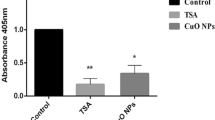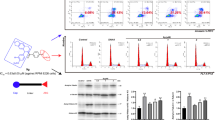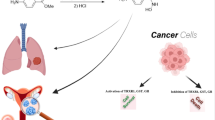Summary
Histone deacetylases (HDACs) play an important role in the epigenetic regulation of gene expression through their effects on the compact chromatin structure. In clinical studies, several classes of histone deacetylase inhibitors (HDACi) have demonstrated potent anticancer activities with metal complexes. Hence, we synthesized cadmium–proline complexes using both the D- and L-isomers of proline and evaluated their biological activities by observing the efficiency of their inhibition of HDAC activity, ability to reduce the expression of HDAC isoforms in A549 cells and effect on apoptosis. The synthesized compounds were characterized by UV, IR, NMR spectroscopy and elemental analysis. In-vitro cell toxicity was evaluated by the 3-(4,5-dimethylthiazol-2-yl)-2,5-diphenyl tetrazolium bromide (MTT) assay, and the 50% inhibitory concentration (IC50; 2 μM) was obtained at 12 h. The morphological study at nuclear levels was performed by acridine orange/ethidium bromide (AO/EB) and Hoechst staining, and the results showed an association with cell cycle arrest at the G2/M phase. Both cadmium–proline complexes intensely inhibited HDAC activity at 2 μM concentration. Interestingly, Cd[L-proline]2 was found to be a potent inhibitor for all HDAC isoforms, whereas Cd[D-proline]2 inhibited only HDAC1 and 2. HDACi are novel chemotherapeutic drugs that induce hyperacetylation of histones H3 and H4, counteracting the aberrant repression of genes, such as insulin-like growth factor-binding protein 3 (IGFBP-3), p53, and p21. ERK/MAPK signaling pathway resulted in the downregulation of the expression of matrix metalloproteinases 2 and 9 (MMP-2 and MMP-9), contributing to the inhibition of metastasis in A549 cells. Apoptosis induction was accompanied by the activation of death receptors and their ligands which recruit initiator caspase 8, decrease in mitochondrial membrane potential (ΔΨm), as well as increased Bax/Bcl2 ratio, followed by activation of caspases 9 and 3. Our finding suggests that Cd[L-proline]2 complex accelerates epigenetic rearrangement by HDAC inhibition, which may be the key mechanism for its anticancer activity.









Similar content being viewed by others
References
Reichert DE, Lewis JS, Anderson CJ (1999) Metal complexes as diagnostic tools. Coord Chem Rev 184:3–66
Sava G, Pacor S, Mestroni G, Alessio E (1992) Na [trans-RuCl4 (DMSO) Im], a metal complex of ruthenium with antimetastatic properties. Clin Exp Metastasis 10:273–280
Thomson AJ, Williams RJP, Reslova S (1972) The chemistry of complexes related to cis-Pt(NH3)2Cl2. An anti-tumour drug. Structure and Bonding, Springer 11:1–46
Phang JM, Liu W, Hancock C (2013) Bridging epigenetics and metabolism: role of nonessential amino acids. Epigenetics 8:231–236
Cleare MJ (1974) Transition metal complexes in cancer chemotherapy. Coord Chem Rev 12:349–405
Liu C, Wang M, Zhang T, Sun H (2004) DNA hydrolysis promoted by di-and multi-nuclear metal complexes. Coord Chem Rev 248:147–168
Sava G, Pacor S, Zorzet S, Alessio E, Mestroni G (1989) Antitumour properties of dimethylsulphoxide ruthenium (II) complexes in the Lewis lung carcinoma system. Pharmacol Res 21:617–628
Clarke MJ, Galang RD, Rodriguez VM, Kumar R, Pell S, Bryan DM (1988) Chemical considerations in the design of ruthenium anticancer agents. In Platinum and Other Metal Coordination Compounds in Cancer Chemotherapy Springer, Boston, pp 582–600
Jones PA, Baylin SB (2002) The fundamental role of epigenetic events in cancer. Nat Rev Genet 3:415–428
Glozak MA, Seto E (2007) Histone deacetylases and cancer. Oncogene 26:5420–5432
Richards EJ, Elgin SCR (2002) Epigenetic codes for heterochromatin formation and silencing: rounding up the usual suspects. Cell 108:489–500
Johnstone RW (2002) Histone-deacetylase inhibitors: novel drugs for the treatment of cancer. Nat Rev Drug Discov 1:287–299
Diyabalanage HVK, Granda ML, Hooker JM (2013) Combination therapy: histone deacetylase inhibitors and platinum-based chemotherapeutics for cancer. Cancer Lett 329:1–8
Riley T, Sontag E, Chen P, Levine A (2008) Transcriptional control of human p53-regulated genes. Nat Rev Mol cell Biol. 9:402–412
Miller TA, Witter DJ, Belvedere S (2003) Histone deacetylase inhibitors. J Med Chem 46:5097–5116
Thingom B, Moirangthem SD, Laitonjam WS (2013) Cadmium- proline catalyzed direct asymmetric michael and aldol reactions in water. Indian J Chem 52B:929–936
Yuan JP, Wang GH, Ling H, Su Q, Yang YH, Song Y, Tang RJ, Liu Y, Huang C (2004) Diallyl disulfide-induced G2/M arrest of human gastric cancer MGC803 cells involves activation of p38 MAP kinase pathways. World J Gastroenterol 10:2731–2734
Karthik S, Sankar R, Varunkumar K, Anusha C, Ravikumar V (2015) Blocking NF-κB sensitizes non-small cell lung cancer cells to histone deacetylase inhibitor induced extrinsic apoptosis through generation of reactive oxygen species. Biomed Pharmacother 69:337–344
Wu JG, Ma L, Zhang SY (2011) Essential oil from rhizomes of Ligusticum chuanxiong induces apoptosis in hypertrophic scar fibroblasts. Pharm Biol 49:86–93
Liu X-S, John BL, Yuan Z-M (2015) Glycolytic metabolism influences global chromatin structure. Oncotarget 6(6):4214–4225
Karthik S, Sankar R, Varunkumar K, Ravikumar V (2014) Romidepsin induces cell cycle arrest, apoptosis, histone hyperacetylation and reduces matrix metalloproteinases 2 and 9 expression in bortezomib sensitized non-small cell lung cancer cells. Biomed Pharmacother 68:327–334
Karmakar T, Kuang Y, Neamati N, Baruah JB (2013) Cadmium complexes and cocrystals of indium complexes of benzothiazole derivatives and anticancer activities of the cadmium complexes. Polyhedron 54:285–293
Hsieh YH, Wu TT, Huang CY, Hsieh YS, Hwang JM, Liu JY (2007) p38 mitogen-activated protein kinase pathway is involved in protein kinase Cα–regulated invasion in human hepatocellular carcinoma cells. Cancer Res 67:4320–4327
Lu P, Weaver VM, Werb Z (2012) The extracellular matrix: a dynamic niche in cancer progression. J Cell Biol 196:395–406
Moulik S, Pal S, Biswas J, Chatterjee A (2014) Role of ERK in modulating MMP 2 and MMP 9 with respect to tumour invasiveness in human cancer cell line MCF-7 and MDA-MB-231. J Tumor 2:2
Horiuchi H, Kawamata H, Furihata T, Omotehara F, Hori H, Shinagawa Y, Ohkura Y, Tachibana M, Yamazaki T, Ajiki T, Kuroda Y (2004) A MEK inhibitor (U0126) markedly inhibits direct liver invasion of orthotopically inoculated human gallbladder cancer cells in nude mice. J Exp Clin cancer Res CR 23:599–606
Sherr CJ, Roberts JM (1999) CDK inhibitors: positive and negative regulators of G1-phase progression. Genes Dev 13:1501–1512
Delcuve GP, Khan DH, Davie JR (2012) Roles of histone deacetylases in epigenetic regulation: emerging paradigms from studies with inhibitors. Clin Epigenetics 4:1–13
Kurdistani SK, Grunstein M (2003) Histone acetylation and deacetylation in yeast. Nat Rev Mol cell Biol. 4:276–284
Martínez-Iglesias O, Ruiz-Llorente L, Sánchez-Martínez R, García L, Zambrano A, Aranda A (2008) Histone deacetylase inhibitors: mechanism of action and therapeutic use in cancer. Clin Transl Oncol 10:395–398
De Ruijter AJ, Van Gennip AH, Caron HN, Stephan KEMP, Van Kuilenburg AB (2003) Histone deacetylases (HDACs): characterization of the classical HDAC family. Biochem J 370(3):737–749
Witt O, Deubzer HE, Milde T, Oehme I (2009) HDAC family: what are the cancer relevant targets? Cancer Lett 277(1):8–21
Marks PA (2010) Histone deacetylase inhibitors: a chemical genetics approach to understanding cellular functions. Biochimica et Biophysica Acta (BBA)-Gene Regulatory Mechanisms 1799(10):717–725
Minucci S, Pelicci PG (2006) Histone deacetylase inhibitors and the promise of epigenetic (and more) treatments for cancer. Nat Rev Cancer 6(1):38–51
Wang GG, Allis CD, Chi P (2007) Chromatin remodeling and cancer. Part I: Covalent histone modifications Trends Mol Med 13:363–372
Laptenko O, Prives C (2006) Transcriptional regulation by p53: one protein, many possibilities. Cell Death Differ 13:951–961
Lin RJ, Nagy L, Inoue S, Shao W, Miller WH, Evans RM (1998) Role of the histone deacetylase complex in acute promyelocytic leukaemia. Nature 391:811–814
Wu JT, Archer SY, Hinnebusch B, Meng S, Hodin RA (2001) Transient vs. prolonged histone hyperacetylation: effects on colon cancer cell growth, differentiation, and apoptosis. Am J Physiol Liver Physiol 280:G482–G490
Taipale J, Beachy PA (2001) The hedgehog and Wnt signalling pathways in cancer. Nature 411:349–354
Levine AJ (1997) p53, the cellular gatekeeper for growth and division. Cell 88:323–331
Rajah R, Valentinis B, Cohen P (1997) Insulin-like growth factor (IGF)-binding protein-3 induces apoptosis and mediates the effects of transforming growth factor-β1 on programmed cell death through a p53-and IGF-independent mechanism. J Biol Chem 272:12181–12188
Gill ZP, Perks CM, Newcomb PV, Holly JMP (1997) Insulin-like growth factor-binding protein (IGFBP-3) predisposes breast cancer cells to programmed cell death in a non-IGF-dependent manner. J Biol Chem 272:25602–25607
Reed JC (2003) Apoptosis-targeted therapies for cancer. Cancer Cell 3:17–22
Elmore S (2007) Apoptosis: a review of programmed cell death. Toxicol Pathol 35:495–516
Pajaniradje S, Mohankumar K, Pamidimukkala R, Subramanian S, Rajagopalan R (2014) Antiproliferative and apoptotic effects of Sesbania grandiflora leaves in human cancer cells Biomed Res Int:2014
Diaz-Moralli S, Tarrado-Castellarnau M, Miranda A, Cascante M (2013) Targeting cell cycle regulation in cancer therapy. Pharmacol Ther 138:255–271
Hsiao CJ, Hsiao G, Chen WL, Wang SW, Chiang CP, Liu LY, Guh JH, Lee TH, Chung CL (2014) Cephalochromin induces G0/G1 cell cycle arrest and apoptosis in A549 human non-small-cell lung cancer cells by inflicting mitochondrial disruption. J Nat Prod 77:758–765
Guh J, Lee T, Chung C (2014) Cephalochromin induces G0/G1 cell cycle arrest and apoptosis in A549 human non-small-cell lung cancer cells by inflicting mitochondrial disruption. J Nat Prod 77(4):758–765
Li D, Ueta E, Kimura T, Yamamoto T, Osaki T (2004) Reactive oxygen species (ROS) control the expression of Bcl-2 family proteins by regulating their phosphorylation and ubiquitination. Cancer Sci 95:644–650
Chen KC, Kao PH, Lin SR, Chang LS (2009) Upregulation of Fas and FasL in Taiwan cobra phospholipase A2-treated human neuroblastoma SK-N-SH cells through ROS-and Ca2+−mediated p38 MAPK activation. J Cell Biochem 106:93–102
Pulido MD, Parrish AR (2003) Metal-induced apoptosis: mechanisms. Mutat Res Mol Mech Mutagen. 533:227–241
Tuschl H, Schwab C (2003) Cytotoxic effects of the herbicide 2, 4-dichlorophenoxyacetic acid in HepG2 cells. Food Chem Toxicol 41:385–393
Kannan K, Jain SK (2000) Oxidative stress and apoptosis. Pathophysiology 7:153–163
Desagher S, Martinou JC (2000) Mitochondria as the central control point of apoptosis. Trends Cell Biol 10:369–377
Hayat MA ed (2013) Autophagy: cancer, other pathologies, inflammation, immunity, infection, and aging. Volume 3-role in specific diseases (Vol. 3). Academic Press
Kroemer G, Reed JC (2000) Mitochondrial control of cell death. Nat Med 6(5):513
Certo M, Moore VDG, Nishino M, Wei G, Korsmeyer S, Armstrong SA, Letai A (2006) Mitochondria primed by death signals determine cellular addiction to antiapoptotic BCL-2 family members. Cancer Cell 9:351–365
Chao DT, Korsmeyer SJ (1998) BCL-2 family: regulators of cell death. Annu Rev Immunol 16:395–419
Riedl SJ, Shi Y (2004) Molecular mechanisms of caspase regulation during apoptosis. Nat Rev Mol cell Biol 5:897–907
Acknowledgements
The first author is grateful to Bharathidasan University, Tiruchirappalli, India, for providing financial support through their University Research fellowship (URF) scheme (Ref. number 055441/URF/K7/2013). The fourth author thanks the Department of Science and Technology, Science and Engineering Board (DST-SERB, SB/FT/CS-086/2013), India, for providing research fund. We acknowledge Dr. C. Prahalathan and Dr. A. Antony Joseph Velanganni, Department of Biochemistry, Bharathidasan University, Tiruchirappalli, India, for their help with gel documentation and fluorescence microscopic studies. We are grateful to the Department of Science and Technology–Fund for Improvement of S&T Infrastructure in Universities and Higher Educational Institutions (DST-FIST) for their infrastructure support to our department.
Author information
Authors and Affiliations
Corresponding authors
Ethics declarations
Conflict of interest
All authors declare that they have no conflicts of interest.
Funding
The study was supported by the Department of Science and Technology, Science and Engineering Board (DST-SERB, SB/FT/CS-086/2013), India.
Ethical approval
This article does not contain studies involving human participants or animals.
Electronic supplementary material
Rights and permissions
About this article
Cite this article
Chidambaram, A., Sekar, A., S.H., K. et al. Synthesis, characterization, and evaluation of Cd[L-proline]2, a novel histone deacetylase inhibitor that induces epigenetic modification of histone deacetylase isoforms in A549 cells. Invest New Drugs 35, 691–705 (2017). https://doi.org/10.1007/s10637-017-0489-1
Received:
Accepted:
Published:
Issue Date:
DOI: https://doi.org/10.1007/s10637-017-0489-1




